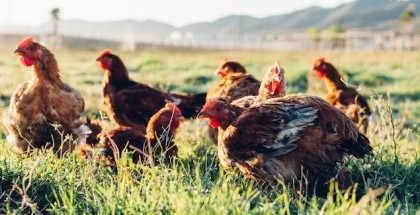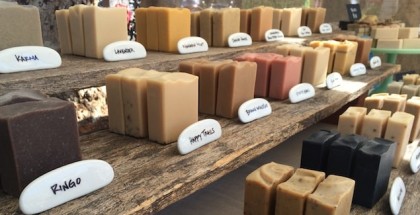GrowRIVERSIDE Homegrown Riverside Recipe Contest
May 5, 2015 | seedstock

The “Homegrown Riverside Recipe Contest” is entering its inaugural year. The contest seeks to highlight the abundance of local food in Riverside and inspire new recipes and ways of cooking throughout our greater Riverside community. The “Homegrown Riverside Recipe Contest” aims to connect chefs, food entrepreneurs, cottage food providers and home cooks. Contest winners will be announced at the GrowRIVERSIDE Conference. The 1st place winner will have their recipe featured for distribution at Community Day on June 13. Applications will be received according to the contest instructions and rules from now until the end of May!
Contest Rules and Details:
Home cooks are encouraged to submit a recipe that features at least one (1) local item of produce purchased at a farmer’s market or farm stand in Riverside or San Bernardino Counties.
Each recipe submitted must also be accompanied by a short essay, limited to no more than 250 words, addressing the following points:
- Identify the local produce ingredient(s) featured in the recipe. The local ingredients must be produce items that are grown within Riverside or San Bernardino Counties.
- Explain how using local ingredients in your home cooking is better for you and your family.
In addition, the entry must include an upload (digital attachment) of a digital photograph of your prepared and original recipe (color photo). The photo must be of the dish prepared by you (no professional photographs).
Recipe requirements:
The recipe must be original (created by you) and not previously published (in print or online) or have won another award. Submission of a recipe is a warranty by the contestant that the contestant owns all copyrights and other intellectual property rights to the recipe and constitutes an assignment of these rights to GrowRIVERSIDE (sometimes referred to as “Sponsor”).
The recipe must have a descriptive title, include exact measurements with step-by-step instructions for preparation and completion. Each ingredient, including the local ingredient(s), must be listed, preferably in order of use, followed by complete, step-by-step cooking instructions, including timing, temperature and size of pot, pan, etc. used for any cooked components.
How to Enter:
Beginning May 1, 2015, recipes may be submitted via e-mail to We GrowRIVERSIDE at the following e-mail address: email hidden; JavaScript is required. The recipe may be sent as an attachment, in Microsoft Word format, or PDF, or the recipe may be typed into the body of the e-mail. The essay may be attached as a separate document, or may be included at the end of the recipe. The photo must be attached as a separate file (jpg format).
The contestant name, address, telephone number and email MUST be included at the end of each entry.
All recipes, essays and photos (collectively “entries”) submitted become the property of GrowRIVERSIDE. By entering the Contest, all participants consent to the commercial use of their name, picture, and recipe for advertising and publicity purposes without further compensation.
The deadline for entering is May 30, 2015 at 6 p.m. Pacific Time. Submissions received after the deadline will not be considered.
Selection of Winners:
A panel of three (3) judges, including local cottage food entrepreneurs, Laurie Anderson of Etta Mae Gourmet and Laureen Pittman of The Spice Whisperer, will judge the eligible recipes and select the winners. Winners will be selected on or about June 5, 2015. Three winners will be selected:
First Place
Second Place
Third Place
Judges will score every eligible entry by each of the following criteria to determine the winners:
Perceived taste (25%)
Presentation (eye appeal in photo submitted) (25%)
Ease of preparation (25%)
Creativity of Recipe and Essay (25%)
Winners will be notified no later than June 10, 2015 via e-mail or telephone.
The winners’ recipes will be published on the GrowRIVERSIDE website. The First Place winner will be announced at the GrowRIVERSIDE Conference on June 12 and recipe cards with the First Place recipe and photo will be available to attendees at the conference.
Eligibility:
Recipe Contest is open to non-professional, home cooks. PROFESSIONAL CHEFS, CATERERS, OR OTHER FOOD PROFESSIONALS ARE NOT ELIGIBLE TO ENTER. NO PURCHASE NECESSARY TO ENTER OR WIN. PURCHASE WILL NOT INCREASE ODDS OF WINNING. CONTEST OPEN ONLY TO RESIDENTS OF RIVERSIDE AND SAN BERNARDINO COUNTIES WHO ARE AGE 18 OR OLDER. To be eligible, entries must be completed and received by Sponsor in the format designated above NO LATER THAN MAY 3O, 2015 AT 6 P.M. LOCAL TIME. All applicable federal, state and local laws and regulations apply. Offer void where prohibited or restricted by law. Limit one entry per person.
Odds of winning depend on number of eligible entries received and the quality of the entries received.
Miscellaneous:
Internet access, e-mail and uploading capability required to enter.
GrowRIVERSIDE Says: Eat Local!
Eating local foods is better for you, for the environment, and (most importantly) for your taste buds. Here are the top eight reasons you might want to consider eating more local foods.
- Local Foods Are Fresher (and Taste Better)
Local food is fresher and tastes better than food that has been trucked or flown in from thousands of miles away. Think you can’t taste the difference between lettuce picked yesterday and lettuce picked last week, factory-washed, and sealed in plastic? Do a taste-test at home. We bet you can.
- Local Foods Are Seasonal (and Taste Better)
In-season, locally grown tomatoes burst with flavor! That’s easy to forget if you only eat ones that are artificially ripened. Fresh corn in-season tastes so good in early summer when you haven’t eaten any in 9 or 10 months – long enough for its taste to be a slightly blurred memory that is suddenly awakened with that first bite of the season. The first bite of the season always tastes best. Eating locally means eating seasonally, with all the deprivation and resulting pleasure that accompanies it.
- Local Foods Usually Have Less Environmental Impact
Those thousands of miles some food is shipped? That leads to a big carbon footprint for a little bunch of herbs. Look for local farmers who follow organic and sustainable growing practices and energy use to minimize your food’s environmental impact.
- Local Foods Preserve Green Space & Farmland
The environmental question of where you food comes from is bigger than its “carbon footprint.” By buying foods grown and raised closer to where you live, you help maintain farmland and green space in your area.
- Local Foods Promote Food Safety
The fewer steps there are between your food’s source and your table the less chance there is of contamination. Also, when you know where your food comes from and who grows it, you know a lot more about that food.
- Local Foods Promote Variety
Local foods tend to create a greater variety of foods available. Farmers who run community-supported agriculture programs (CSAs), sell at farmers markets, and provide local restaurants have the demand and hence the economic support for raising more types of produce and livestock.
- Local Foods Support Your Local Economy
Money spent with local farmers, growers, and artisans and locally-owned purveyors and restaurants all stays close to home. When food moves through fewer hands, more of the money you spend tends to get to the people growing it.
- Local Foods Create Community
Knowing where your food is from helps connect you to the people who raise and grow it. Instead of having a single relationship – to a big supermarket – you develop smaller connections to more food sources.












Submit a Comment